Tara Julia Hamilton
University of Western Sydney, University of New South Wales
Investigation of event-based memory surfaces for high-speed tracking, unsupervised feature extraction and object recognition
Nov 08, 2017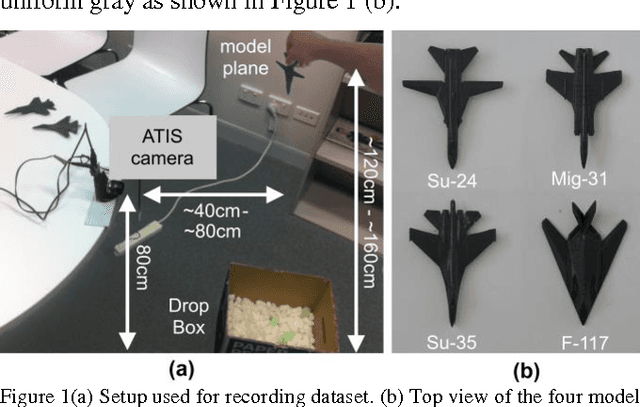

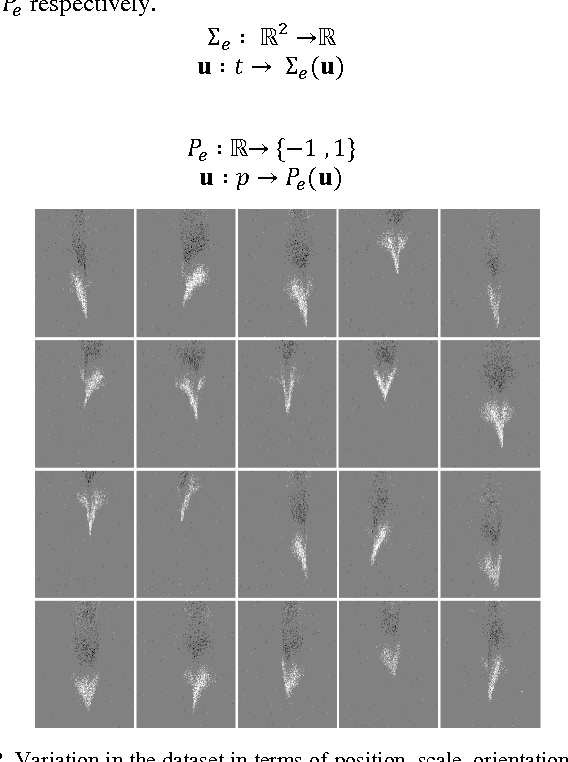
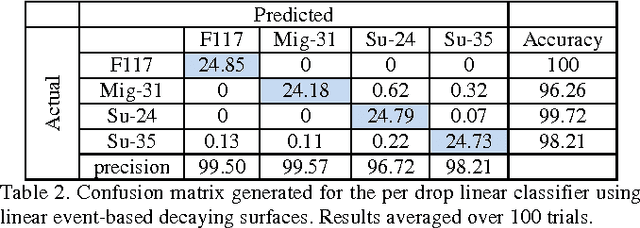
Abstract:In this paper we compare event-based decaying and time based-decaying memory surfaces for high-speed eventbased tracking, feature extraction, and object classification using an event-based camera. The high-speed recognition task involves detecting and classifying model airplanes that are dropped free-hand close to the camera lens so as to generate a challenging dataset exhibiting significant variance in target velocity. This variance motivated the investigation of event-based decaying memory surfaces in comparison to time-based decaying memory surfaces to capture the temporal aspect of the event-based data. These surfaces are then used to perform unsupervised feature extraction, tracking and recognition. In order to generate the memory surfaces, event binning, linearly decaying kernels, and exponentially decaying kernels were investigated with exponentially decaying kernels found to perform best. Event-based decaying memory surfaces were found to outperform time-based decaying memory surfaces in recognition especially when invariance to target velocity was made a requirement. A range of network and receptive field sizes were investigated. The system achieves 98.75% recognition accuracy within 156 milliseconds of an airplane entering the field of view, using only twenty-five event-based feature extracting neurons in series with a linear classifier. By comparing the linear classifier results to an ELM classifier, we find that a small number of event-based feature extractors can effectively project the complex spatio-temporal event patterns of the dataset to an almost linearly separable representation in feature space.
An Online Learning Algorithm for Neuromorphic Hardware Implementation
Jul 30, 2017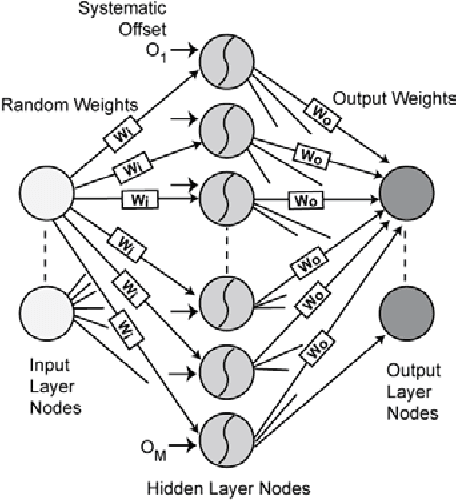

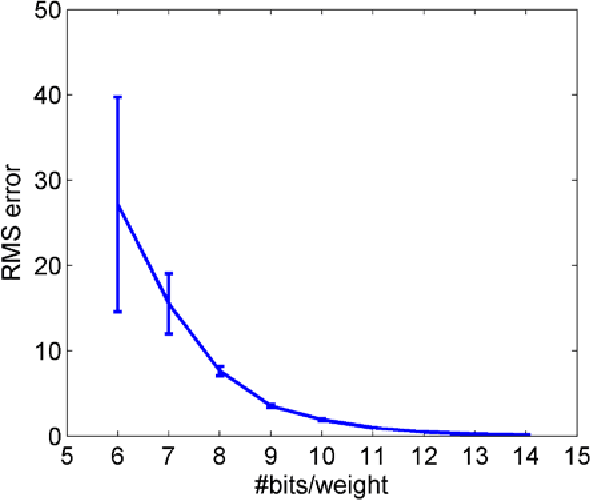

Abstract:We propose a sign-based online learning (SOL) algorithm for a neuromorphic hardware framework called Trainable Analogue Block (TAB). The TAB framework utilises the principles of neural population coding, implying that it encodes the input stimulus using a large pool of nonlinear neurons. The SOL algorithm is a simple weight update rule that employs the sign of the hidden layer activation and the sign of the output error, which is the difference between the target output and the predicted output. The SOL algorithm is easily implementable in hardware, and can be used in any artificial neural network framework that learns weights by minimising a convex cost function. We show that the TAB framework can be trained for various regression tasks using the SOL algorithm.
A Stochastic Approach to STDP
Mar 13, 2016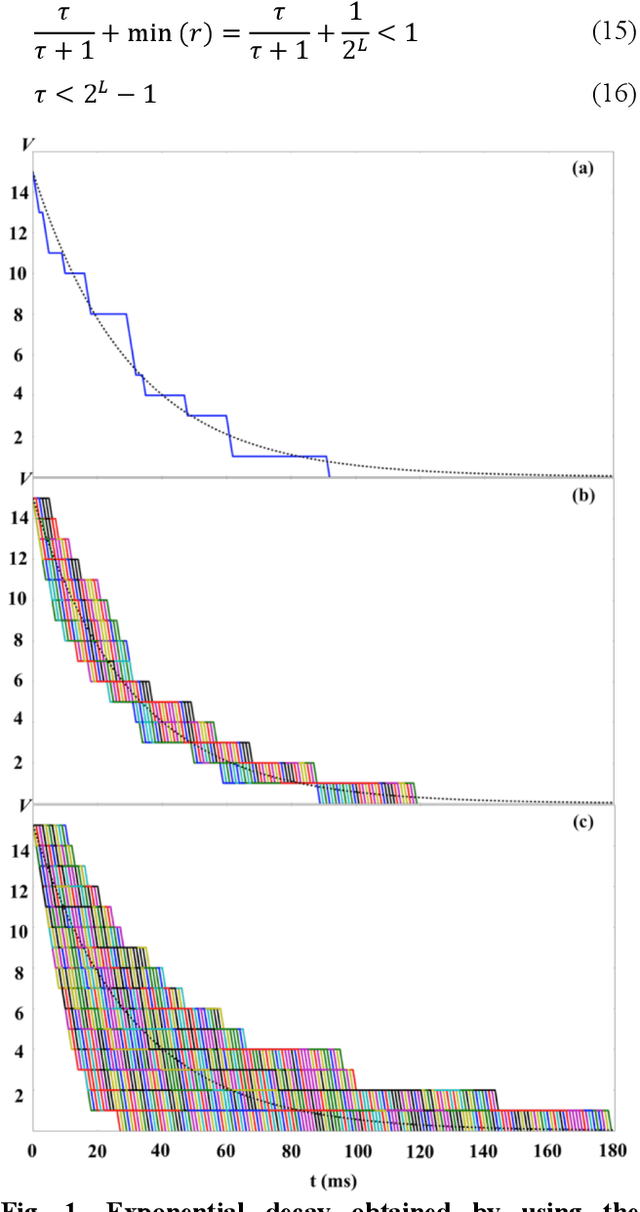
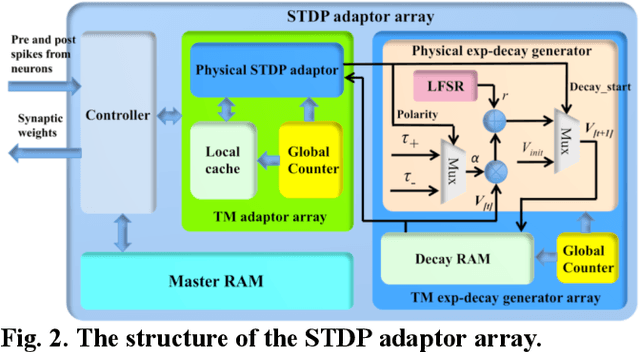
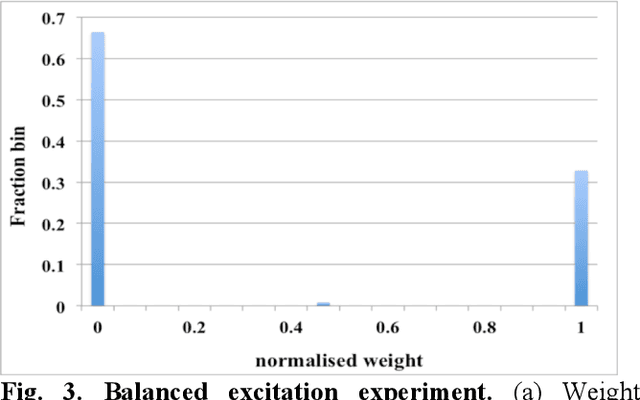

Abstract:We present a digital implementation of the Spike Timing Dependent Plasticity (STDP) learning rule. The proposed digital implementation consists of an exponential decay generator array and a STDP adaptor array. On the arrival of a pre- and post-synaptic spike, the STDP adaptor will send a digital spike to the decay generator. The decay generator will then generate an exponential decay, which will be used by the STDP adaptor to perform the weight adaption. The exponential decay, which is computational expensive, is efficiently implemented by using a novel stochastic approach, which we analyse and characterise here. We use a time multiplexing approach to achieve 8192 (8k) virtual STDP adaptors and decay generators with only one physical implementation of each. We have validated our stochastic STDP approach with measurement results of a balanced excitation/inhibition experiment. Our stochastic approach is ideal for implementing the STDP learning rule in large-scale spiking neural networks running in real time.
A Reconfigurable Mixed-signal Implementation of a Neuromorphic ADC
Sep 03, 2015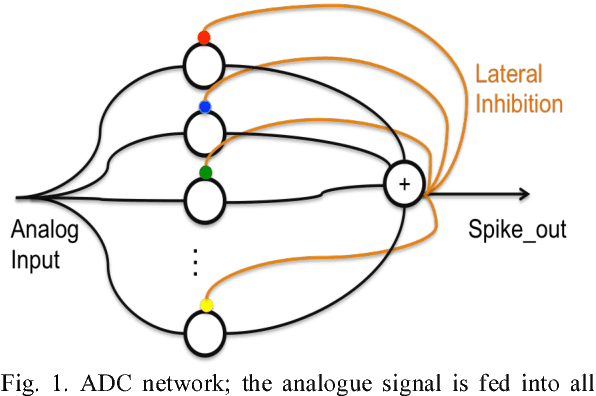
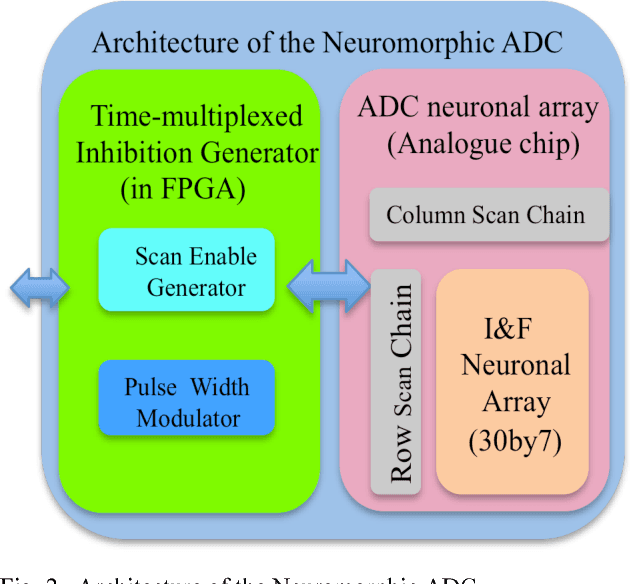
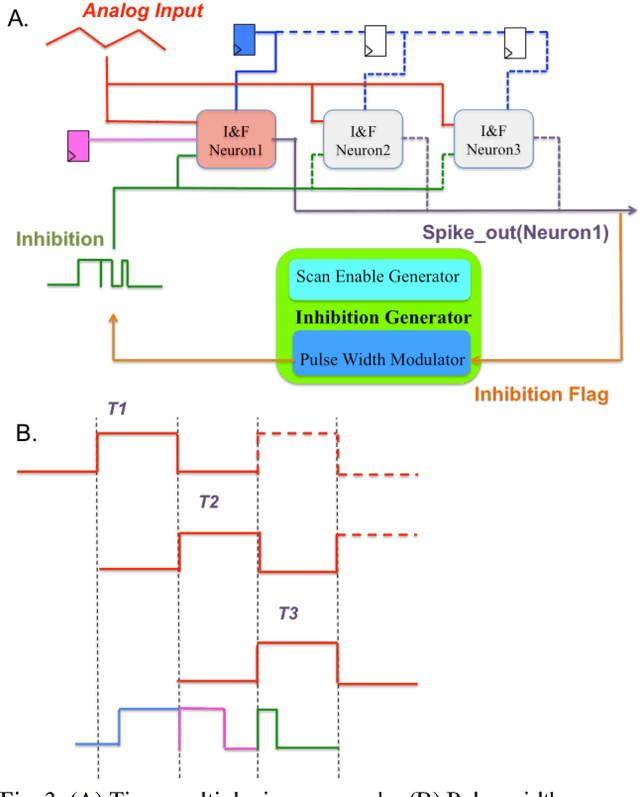
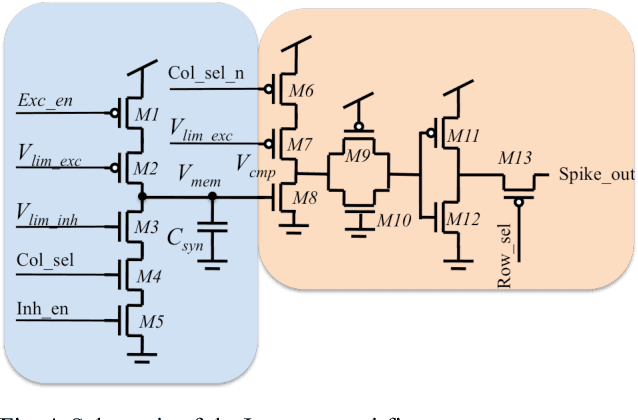
Abstract:We present a neuromorphic Analogue-to-Digital Converter (ADC), which uses integrate-and-fire (I&F) neurons as the encoders of the analogue signal, with modulated inhibitions to decohere the neuronal spikes trains. The architecture consists of an analogue chip and a control module. The analogue chip comprises two scan chains and a twodimensional integrate-and-fire neuronal array. Individual neurons are accessed via the chains one by one without any encoder decoder or arbiter. The control module is implemented on an FPGA (Field Programmable Gate Array), which sends scan enable signals to the scan chains and controls the inhibition for individual neurons. Since the control module is implemented on an FPGA, it can be easily reconfigured. Additionally, we propose a pulse width modulation methodology for the lateral inhibition, which makes use of different pulse widths indicating different strengths of inhibition for each individual neuron to decohere neuronal spikes. Software simulations in this paper tested the robustness of the proposed ADC architecture to fixed random noise. A circuit simulation using ten neurons shows the performance and the feasibility of the architecture.
A compact aVLSI conductance-based silicon neuron
Sep 03, 2015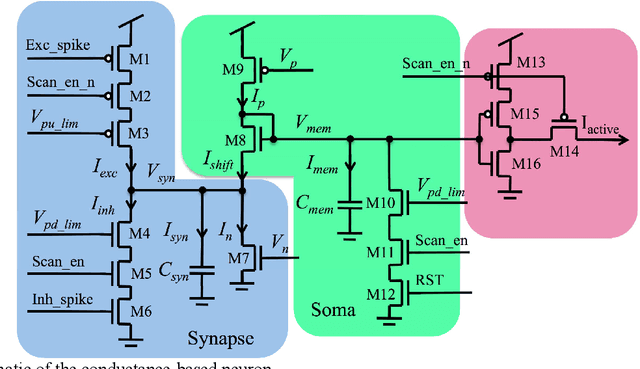
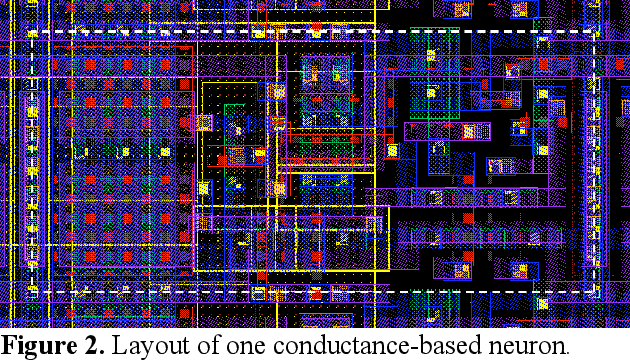
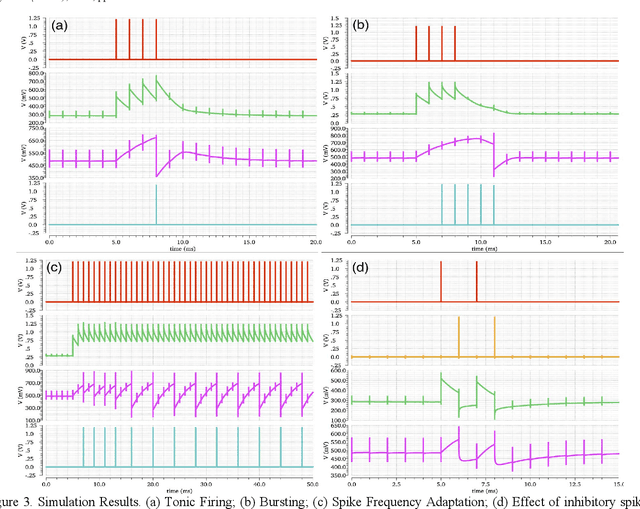
Abstract:We present an analogue Very Large Scale Integration (aVLSI) implementation that uses first-order lowpass filters to implement a conductance-based silicon neuron for high-speed neuromorphic systems. The aVLSI neuron consists of a soma (cell body) and a single synapse, which is capable of linearly summing both the excitatory and inhibitory postsynaptic potentials (EPSP and IPSP) generated by the spikes arriving from different sources. Rather than biasing the silicon neuron with different parameters for different spiking patterns, as is typically done, we provide digital control signals, generated by an FPGA, to the silicon neuron to obtain different spiking behaviours. The proposed neuron is only ~26.5 um2 in the IBM 130nm process and thus can be integrated at very high density. Circuit simulations show that this neuron can emulate different spiking behaviours observed in biological neurons.
A neuromorphic hardware architecture using the Neural Engineering Framework for pattern recognition
Jul 21, 2015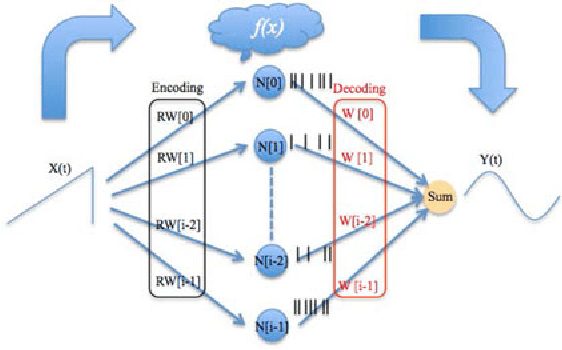
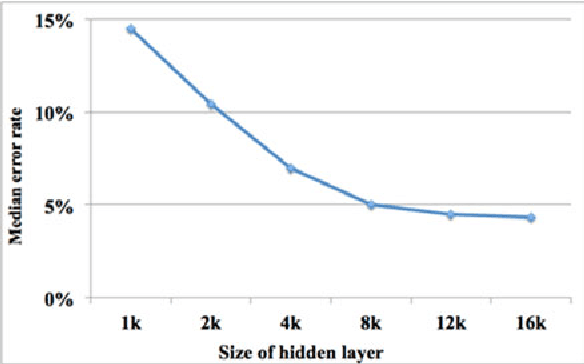
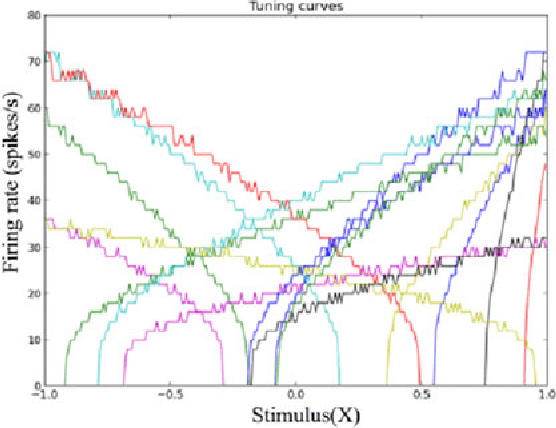
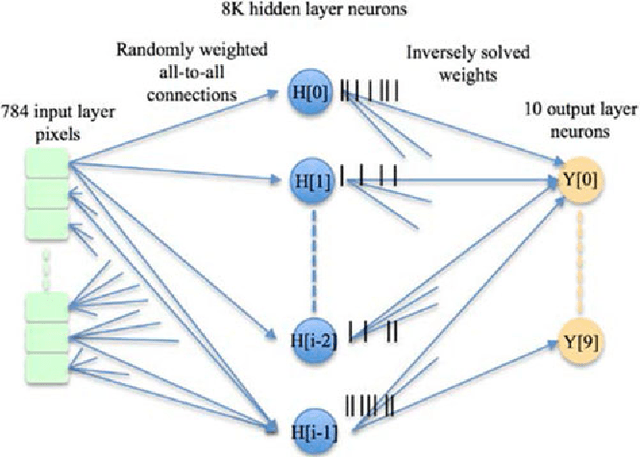
Abstract:We present a hardware architecture that uses the Neural Engineering Framework (NEF) to implement large-scale neural networks on Field Programmable Gate Arrays (FPGAs) for performing pattern recognition in real time. NEF is a framework that is capable of synthesising large-scale cognitive systems from subnetworks. We will first present the architecture of the proposed neural network implemented using fixed-point numbers and demonstrate a routine that computes the decoding weights by using the online pseudoinverse update method (OPIUM) in a parallel and distributed manner. The proposed system is efficiently implemented on a compact digital neural core. This neural core consists of 64 neurons that are instantiated by a single physical neuron using a time-multiplexing approach. As a proof of concept, we combined 128 identical neural cores together to build a handwritten digit recognition system using the MNIST database and achieved a recognition rate of 96.55%. The system is implemented on a state-of-the-art FPGA and can process 5.12 million digits per second. The architecture is not limited to handwriting recognition, but is generally applicable as an extremely fast pattern recognition processor for various kinds of patterns such as speech and images.
A Trainable Neuromorphic Integrated Circuit that Exploits Device Mismatch
Jul 10, 2015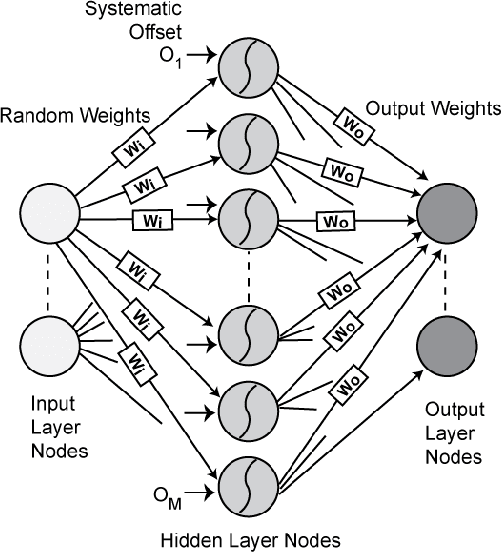
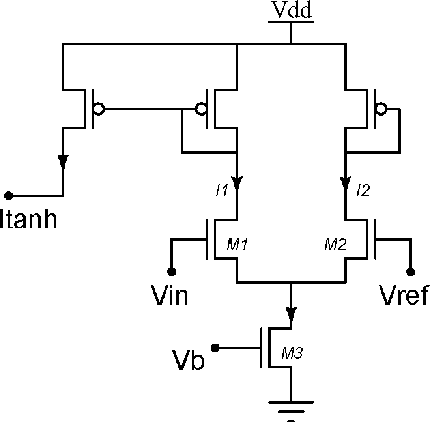
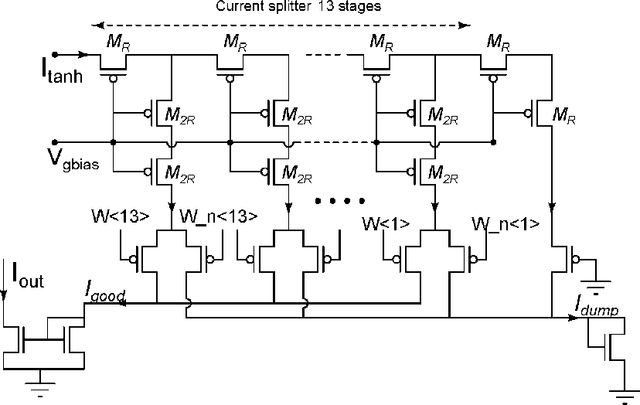
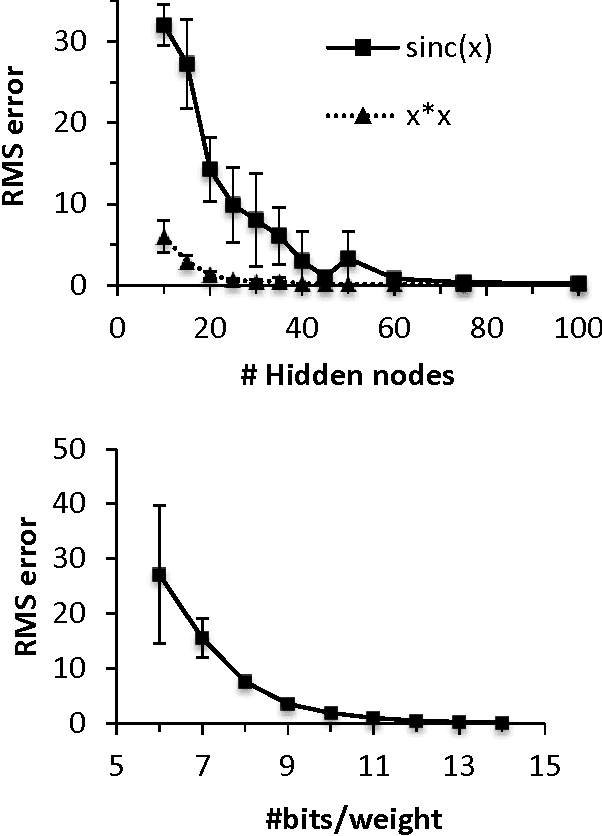
Abstract:Random device mismatch that arises as a result of scaling of the CMOS (complementary metal-oxide semi-conductor) technology into the deep submicron regime degrades the accuracy of analogue circuits. Methods to combat this increase the complexity of design. We have developed a novel neuromorphic system called a Trainable Analogue Block (TAB), which exploits device mismatch as a means for random projections of the input to a higher dimensional space. The TAB framework is inspired by the principles of neural population coding operating in the biological nervous system. Three neuronal layers, namely input, hidden, and output, constitute the TAB framework, with the number of hidden layer neurons far exceeding the input layer neurons. Here, we present measurement results of the first prototype TAB chip built using a 65nm process technology and show its learning capability for various regression tasks. Our TAB chip exploits inherent randomness and variability arising due to the fabrication process to perform various learning tasks. Additionally, we characterise each neuron and discuss the statistical variability of its tuning curve that arises due to random device mismatch, a desirable property for the learning capability of the TAB. We also discuss the effect of the number of hidden neurons and the resolution of output weights on the accuracy of the learning capability of the TAB.
A neuromorphic hardware framework based on population coding
Mar 02, 2015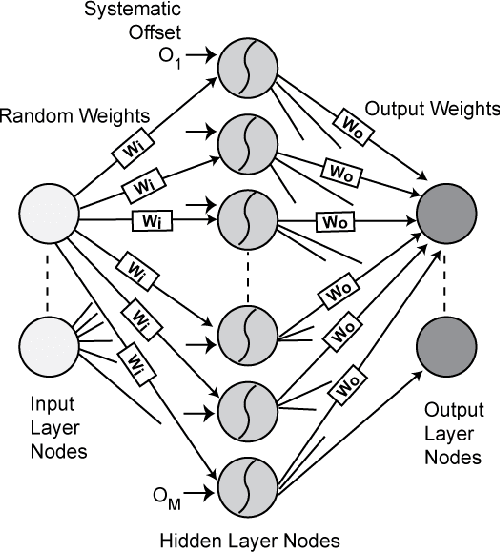
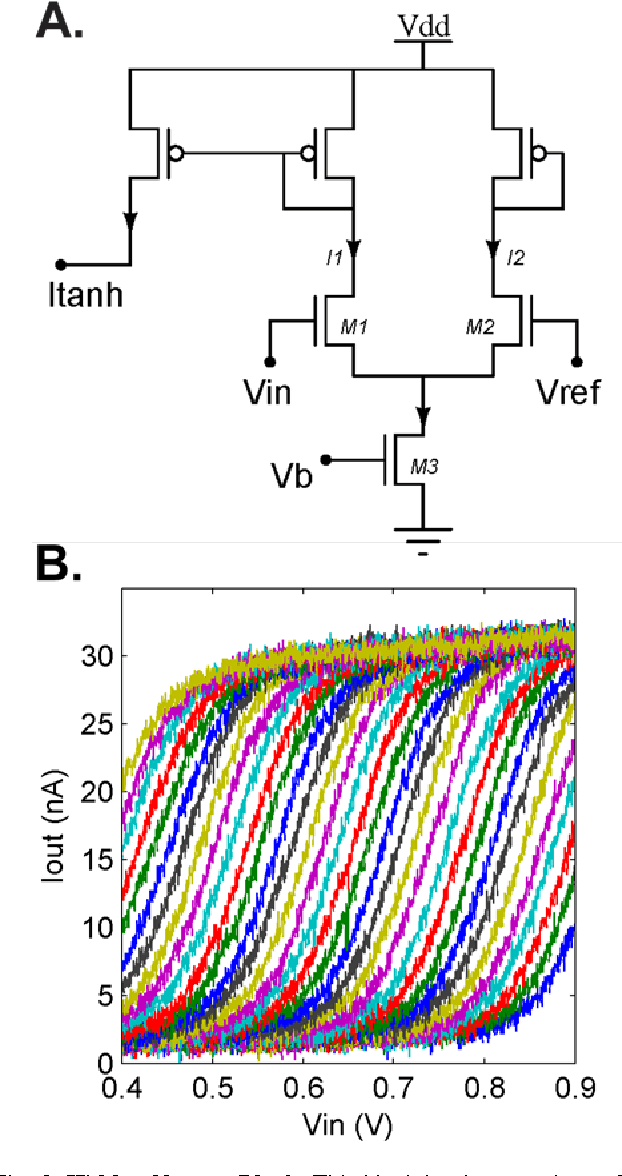
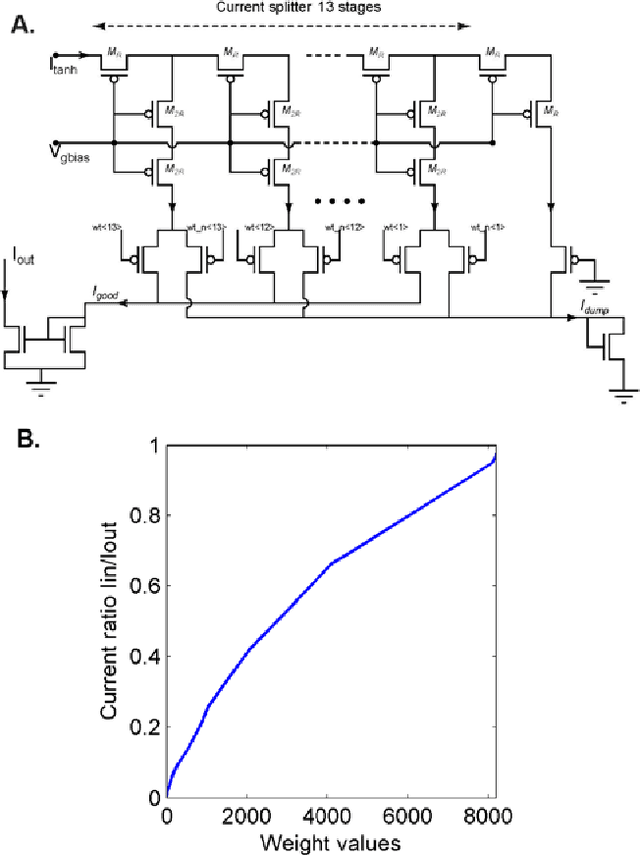
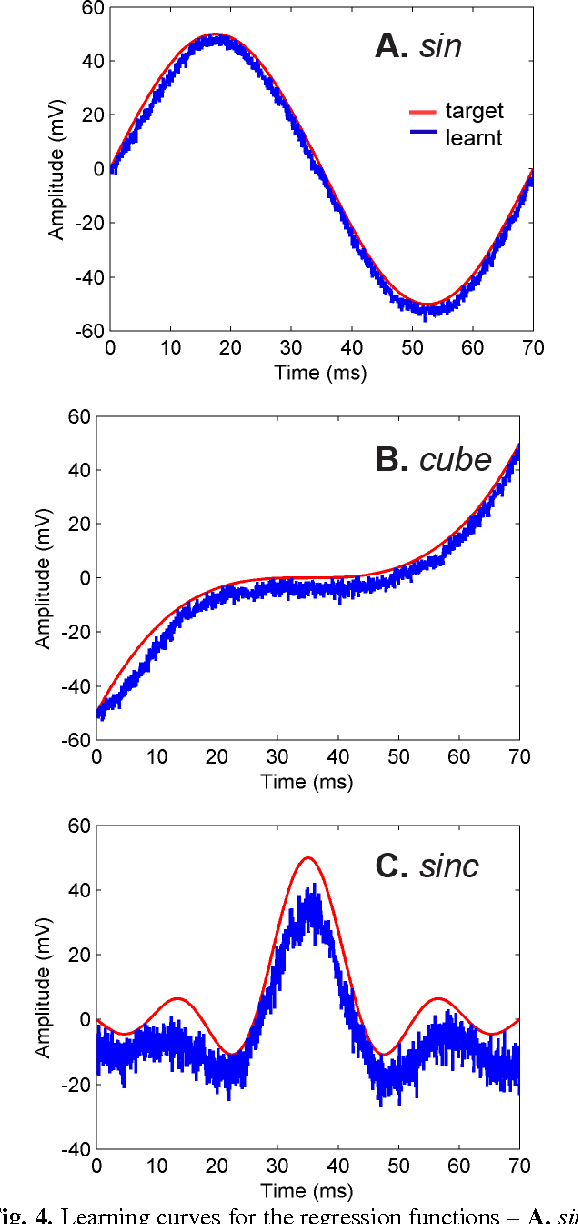
Abstract:In the biological nervous system, large neuronal populations work collaboratively to encode sensory stimuli. These neuronal populations are characterised by a diverse distribution of tuning curves, ensuring that the entire range of input stimuli is encoded. Based on these principles, we have designed a neuromorphic system called a Trainable Analogue Block (TAB), which encodes given input stimuli using a large population of neurons with a heterogeneous tuning curve profile. Heterogeneity of tuning curves is achieved using random device mismatches in VLSI (Very Large Scale Integration) process and by adding a systematic offset to each hidden neuron. Here, we present measurement results of a single test cell fabricated in a 65nm technology to verify the TAB framework. We have mimicked a large population of neurons by re-using measurement results from the test cell by varying offset. We thus demonstrate the learning capability of the system for various regression tasks. The TAB system may pave the way to improve the design of analogue circuits for commercial applications, by rendering circuits insensitive to random mismatch that arises due to the manufacturing process.
FPGA Implementation of the CAR Model of the Cochlea
Mar 02, 2015



Abstract:The front end of the human auditory system, the cochlea, converts sound signals from the outside world into neural impulses transmitted along the auditory pathway for further processing. The cochlea senses and separates sound in a nonlinear active fashion, exhibiting remarkable sensitivity and frequency discrimination. Although several electronic models of the cochlea have been proposed and implemented, none of these are able to reproduce all the characteristics of the cochlea, including large dynamic range, large gain and sharp tuning at low sound levels, and low gain and broad tuning at intense sound levels. Here, we implement the Cascade of Asymmetric Resonators (CAR) model of the cochlea on an FPGA. CAR represents the basilar membrane filter in the Cascade of Asymmetric Resonators with Fast-Acting Compression (CAR-FAC) cochlear model. CAR-FAC is a neuromorphic model of hearing based on a pole-zero filter cascade model of auditory filtering. It uses simple nonlinear extensions of conventional digital filter stages that are well suited to FPGA implementations, so that we are able to implement up to 1224 cochlear sections on Virtex-6 FPGA to process sound data in real time. The FPGA implementation of the electronic cochlea described here may be used as a front-end sound analyser for various machine-hearing applications.
Racing to Learn: Statistical Inference and Learning in a Single Spiking Neuron with Adaptive Kernels
Nov 15, 2014
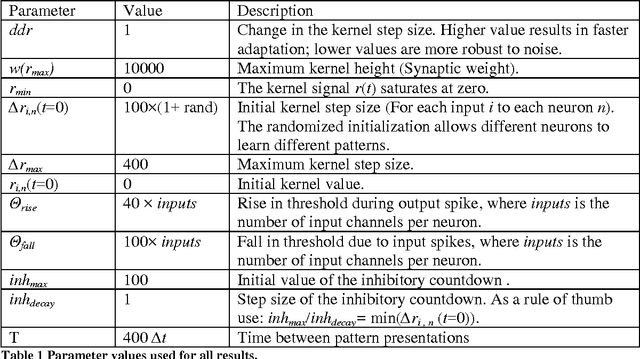


Abstract:This paper describes the Synapto-dendritic Kernel Adapting Neuron (SKAN), a simple spiking neuron model that performs statistical inference and unsupervised learning of spatiotemporal spike patterns. SKAN is the first proposed neuron model to investigate the effects of dynamic synapto-dendritic kernels and demonstrate their computational power even at the single neuron scale. The rule-set defining the neuron is simple there are no complex mathematical operations such as normalization, exponentiation or even multiplication. The functionalities of SKAN emerge from the real-time interaction of simple additive and binary processes. Like a biological neuron, SKAN is robust to signal and parameter noise, and can utilize both in its operations. At the network scale neurons are locked in a race with each other with the fastest neuron to spike effectively hiding its learnt pattern from its neighbors. The robustness to noise, high speed and simple building blocks not only make SKAN an interesting neuron model in computational neuroscience, but also make it ideal for implementation in digital and analog neuromorphic systems which is demonstrated through an implementation in a Field Programmable Gate Array (FPGA).
 Add to Chrome
Add to Chrome Add to Firefox
Add to Firefox Add to Edge
Add to Edge